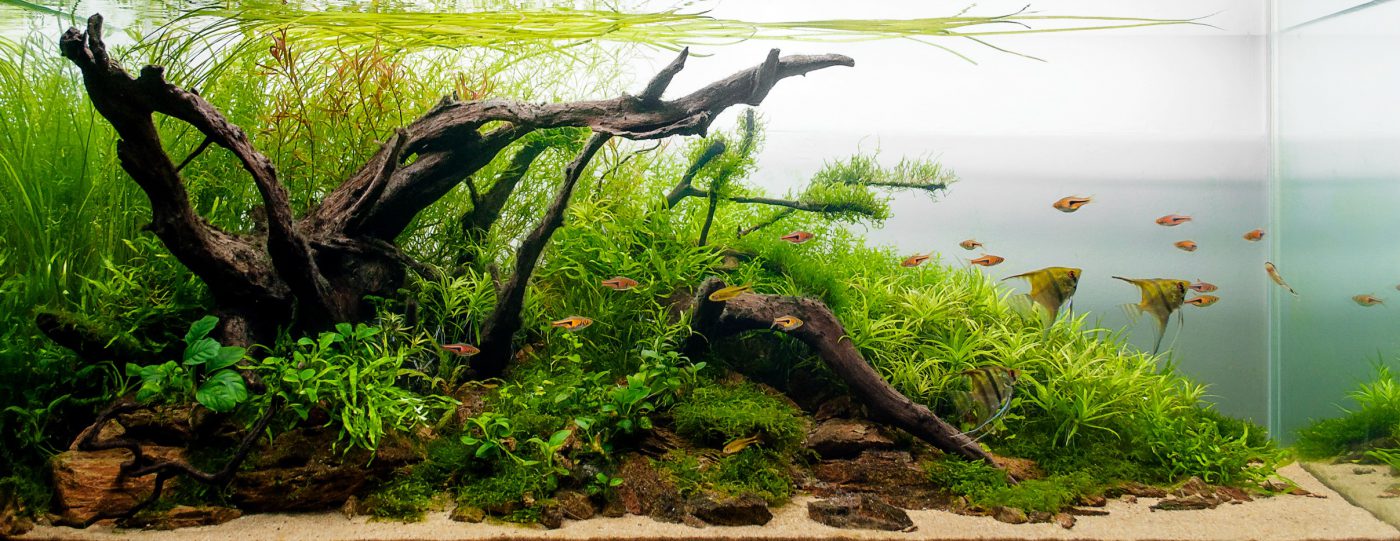One of the most obvious benefits of aquarium plants is how beautiful they make your aquarium look. Traditional aquarium decoration books advise us to consider fore, mid and background planting with increasing height to create a layered effect in the tank. More recently the aquascaping movement draws on a wider range of design principals to create living works of art. For me, this modern avenue has introduced many new angles to the hobby, and is inspiring a new generation of fish keepers.
Creating an enriching environment
Aquarium aesthetics are however something that only humans enjoy; and while it’s great for us to love looking at our tanks, we’re not the ones having to live in them. Though we cannot know if a fish enjoys a tidy home, we certainly know that many captive fishes prefer an ‘enriched’ habitat to a featureless tank. In one study using zebra danios and checker barbs, the fish were found to prefer spending time in an area filled with water sprite (Ceratopteris thalictroides) and small clay pots rather than an empty area, however there was no noticeable difference in behaviours seen in fish in either section. A preference may not mean the fish actually benefits from the presence of plants.
Another study, again with zebra danio, measured the level of the stress hormone cortisol. The researchers found a significantly higher level of tissue in fish that had been kept in groups in featureless tanks compared to those kept in tanks enriched with plants. Interestingly danios kept singly in featureless tanks also showed a significantly lower cortisol response, indicating in this species at least, a complex interaction between habitat complexity and sociability.
Replicate their natural habitat
Fish need this habitat complexity as a sanctuary from perceived threats, aggressive tankmates, and overly enthusiastic spawning partners. The refuge that fine leaved plants such as Cabomba offer are essential for their survival in the wild, but also often in the tank too. Plants even provide spawning substrates for fishes such as freshwater Angelfish and some bubblenesters. Overall, a tank with plants is a much more pleasant environment then a barren one. Gathering the scientific evidence to prove this is much trickier and has only recently been undertaken as the use of fishes in biomedical research gains importance.
A great source of food
So, we can trust our instincts: if I were a fish I would prefer a planted tank. But what other benefits do live plants offer the fish and shrimp in our tanks. For many species the plants are of course food, just watching a goldfish happily destroy some bunched Cabomba or Elodea we can see a fish doing what comes naturally! Many fishes and especially shrimps will prefer to feed not on the plants themselves but on the tiny organisms growing on the surface of the leaves and stems, also known as aufwuchs. More plants mean more surface area, therefore more aufwuchs!
A natural cleaner
What about the benefits that can only be provided by living plants, in other words, what are the impacts the plants have on the aquarium water quality? In order to understand how plants interact with the chemistry of the tank we should refresh our memory on that staple topic of biology class – photosynthesis.
In the wild plants use sunlight to fix carbon dioxide and water, producing sugar and oxygen as shown in the equation below:
6CO2 + 6H2O (Sunlight) C6H12O6 + 6O2
Inside the aquarium, the light that powers aquatic plant photosynthesis comes from the tanks lights and natural illumination. The carbon dioxide is released from the animals and microbes and the oxygen is vital for the sustenance of animal life in the tank. However, it is often forgotten that plants respire in the same way as we animals do. Oxygen is taken in and used for cellular respiration which gives off carbon dioxide as a waste product. When the lights go out, photosynthesis stops, the oxygen concentration can plummet and the carbon dioxide concentration rises. Aeration can help to avoid this problem, but it can also have an adverse effect on dissolved plant nutrients. In the planted tank, it is better to stock fewer small fishes and focus on the many freshwater tropical species that are naturally adapted to low oxygen conditions. Regular testing at various times of day of dissolved oxygen, pH and KH (thus allowing extrapolation of the carbon dioxide concentration), is vital in the heavily-planted, intensely-illuminated, carbon dioxide-supplemented planted tank. Tetra’s 6-in-1 test kits are a quick way of testing the pH, oxygen and chemical levels in your aquarium without disturbing your fish or their surrounding habitat.
The lush plant growth in a well maintained planted tank will have other impacts on the water chemistry. As the plants grow they will extract nutrients from the water column, most notably nitrogen as nitrate and phosphorous as phosphate. An unplanted aquarium has no natural sink for these nutrients, they are only diluted at each water change and filter/gravel clean. With nitrate and phosphate in plentiful supply, algae growth is almost inevitable, the type of algae arising depending on the intensity of the illumination of the tank. The planted aquarium does have a natural output for these nutrients so the plants can outcompete the opportunistic algae. Getting the balance right in a planted aquarium is difficult, algae growth can still be a battle, but at least through the addition of live plants we are tipping the balance out of the favour of the algae. Tetra AlguMin is effective against aquarium algae helping to reduce its dominance in tanks with insufficient higher plant growth,.
It is not only dissolved nutrients the plants require, the root network uptakes micronutrients from the substrate. Tetra’s two planting substrates (Complete Substrate and Active Substrate) are rich in the correct micronutrients required by aquarium plants and are porous and compaction resistant to allow the roots to ramify through the substrate. As the root matrix develops this helps to bind and secure the substrate. As the substrate ages and micronutrients start to deplete, tablets of Tetra Crypto can be added locally to the plant to revitalise the plant with a fresh supply of micronutrients.
The benefits live plants have in the aquarium extend way beyond the aesthetic. Recent research tells us what would seem obvious, that fish are likely to prefer to swim amongst the complex habitat offered by aquatic plants. As the plants grow they interact with the aquarium ecosystem, mainly for the benefit of the fish. They are not a substitute for a filter and aquarium maintenance, but a tank with more dissolved oxygen, less nitrate and phosphate produces more vibrant aquarium fish and shrimp.

